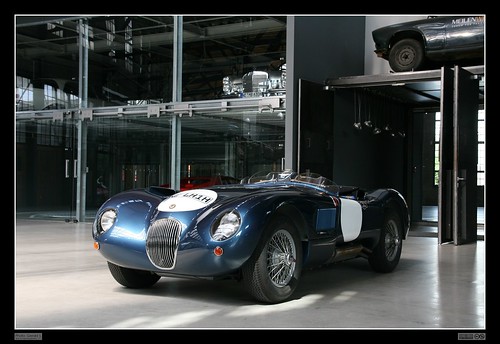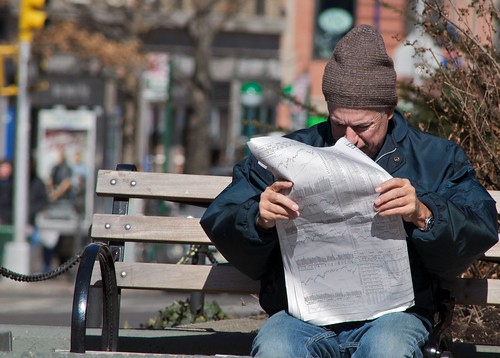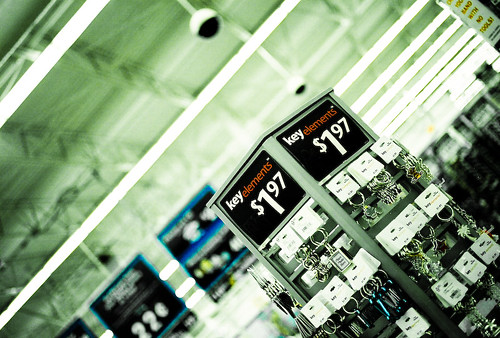1951 Jaguar XK 120 C (C-Type)
Image by Georg Schwalbach (GS1311)
The Jaguar C-Type (also called the Jaguar XK120-C) is a racing car built by Jaguar and sold from 1951 to 1953. Its aerodynamic body was designed by Malcolm Sayer, its lightweight, multi-tubular, triangulated frame designed by Bob Knight. A total of 52 were built.
The "C" designation stood for 'competition', there being no A- or B-Type Jaguars.
Mechanically, it used the running gear of the contemporary XK120 sports car. The twin-cam, straight-6 engine was tuned to around 205 bhp (153 kW) rather than 160 to 180 bhp (134 kW) of the road car. The custom, tubular chassis and aluminium body-panels, along with the elimination of all creature-comforts, helped the car to shed nearly 1,000 lb (450 kg) compared to a comparable Jaguar road-car. The later C-Types were more powerful, using triple twin-choke Weber carburettors and high-lift camshaft. They were also lighter and better braked, by means of all-round disc brakes.
The Jaguar C-Type won the Le Mans 24 hours race at its first attempt in 1951, driven by Peter Walker and Peter Whitehead. Stirling Moss also drove one of the cars, but retired after running very strongly. In 1952 Jaguar, worried by reports of the speed of the Mercedes-Benz 300SL, modified the aerodynamics to increase the top speed. However, this necessitated a rearrangement of the car's cooling system, and subsequently all three entries retired due to overheating. In 1953 the car won again, in a lightened, more powerful configuration, driven by Duncan Hamilton and Tony Rolt. This victory marked the first time the race had been won at an average of over 100 mph (105.85 mph {170.34 km/h}, to be precise). 1954, the C-Type's final year at Le Mans, saw a fourth place by the Ecurie Francorchamps entry driven by Roger Laurent and Jacques Swaters.
When new, the car sold for approximately ,000 - approximately twice the price of an XK120. In an article in the June 11, 2003 issue of Autocar magazine ("Slick Cat Jaguar", p.70) the value of a "genuine, healthy" C-Type is estimated as £400,000, and the value of the 1953 Le Mans winner is circa £2 million while replicas are available from a variety of sources from £40,000.
(Wikipedia)
- - -
Der Jaguar C-Type (eigentlich Jaguar XK 120 C, das C stand für Competition = Wettbewerb) war ein zweisitziger Sportwagen für den Rennbetrieb, der 1951 um den verbesserten Motor des Jaguar XK 120 herum entwickelt wurde.
Der C-Type besaß einen Sechszylinder-Motor XK 120 mit 3442 cm³ mit 200 bhp. Damit erreichten diese Rennfahrzeuge 232 km/h. Sie waren mit Girling-Trommelbremsen an allen vier Rädern ausgestattet. Der C-Type kam erstmals im Mai 1951 auf die Rennstrecke, und das Team Peter Walker/Peter Whitehead errang im 24-Stunden-Rennen von Le Mans sofort den Sieg.
Eine Straßenzulassung war damals für solche Wagen ohne Wetterschutz nichts Ungewöhnliches, da sie in der Regel auf eigener Achse zu den verschiedenen Rennstrecken fuhren.
Jaguar C-Type von 1953 beim Oldtimer-Grand-Prix 2002 auf dem NürburgringWährend die „Production“-Kleinserie von 1952 der ursprünglichen Spezifikation entsprach, setzte Jaguar selbst bereits eine verbesserte und leistungsstärkere Variante ein. Nachdem Stirling Moss wegen der anscheinend überragend schnellen Mercedes-Benz 300 SL die Techniker zu hastigen aerodynamischen Verbesserungen veranlasst hatte, erwiesen sich gerade diese im Rennen von Le Mans als Handicap: Alle Fahrzeuge fielen wegen Überhitzung aus.
Für 1953 bot Jaguar nochmals verbesserte, in der äußeren Linienführung wieder der ursprünglichen Ausführung entsprechende C-Types mit nochmals erhöhter Leistung, zum Teil bereits mit Dunlop-Scheibenbremsen, auf.
Gitterrohrrahmen C-Type1954 wurde der C-Type nach 53 Exemplaren und einem noch auf dem Gitterrohrrahmen des C-Type basierenden Übergangsprototyp „XKC 054“ durch den Jaguar D-Type abgelöst.
(Wikipedia)
What?!? Microsoft's stock price dropped ? Is Windows 7 *that* bad?
Image by Ed Yourdon
Note: moments after this photo was uploaded to Flickr, it was published as an illustration in an undated (Mar 2010) Squidoo blog titled "The Most Random Lens Alive." It was also published as an illustration in an undated (Mar 2010) EveryBlock NYC blog, titled "zipcode: 10025, as well as a related EveryBlock NYC blog page titled neighborhoods: upper west side." And it was published as an illustration in an undated Squidoo blog titled "Penny Stocks: A Helpful Primer." It was also published in an Apr 20, 2010 Penny Black Rubber Stamps blog, with the same title as the caption that I used on this Flickr page. And it was published in a Jul 4, 2010 blog titled, "How to Trade Penny Stocks." And it was published in an undated (mid-Oct 2010) blog titled "Tips for New Stock Market Investors." It was also published in a Nov 15, 2010 blog titled "Hot Penny Stocks > Best Cheap Stocks to Buy – Good OTCBB Micro Cap Picks," as well as an undated (late Nov 2010) blog titled "Penny Stocks To Watch." And it was published in a Dec 10, 2010 blog titled "Cheap Penny Stocks Picks > Hot OTCBB Stocks to Buy Right Now." It was also published in a Dec 13, 2010 Black Hat Networker blog with the same title and detailed notes that I had written on this Flickr page.
Moving into 2011, the photo was published in an undated (mid-Jan 2011) blog titled "A Penny Stock Trading Formula That Turned ,000 into 00,000 in 1 Month With Just 38 Penny Stock Trades!" It was also published in a Jan 18, 2011 Articles Directory blog, with the same title as the caption that I chose for this Flickr page. And it was published in a Feb 15, 2011 Latest Cheap Stock Trading News blog, with the same caption and detailed notes that I had written on this Flickr page. It was also published in an Apr 15, 2011 blog curiously titled "Marketing Timber for Handle Stock in Indiana, 1937." And it was published in a Jun 5, 2011 MetaSwing Training blog with the same caption and detailed notes that I had written on this Flickr page. It was also published in an Aug 2, 2011 blog titled "What the Heck is a Penny Stock?" And it was published in an Aug 15, 2011 股票明牌 blog, with the same caption that I used for this Flickr page, but with no detailed notes at all. It was also published in a Nov 1, 2011 LightEffect blog, with the same caption and detailed notes that I had written on this Flickr page. And it was published in a Nov 9, 2011 blog titled "How Does Pairs Trading Work?"
Moving into 2012, the photo was published in a Jul 6, 2012 blog titled "Nice Investing In Penny Stock photos."
*****************
This is the continuation of a photo-project that I began in the summer of 2008 (which you can see in this Flickr set), and continued throughout 2009 (as shown in this Flickr set): a random collection of "interesting" people in a broad stretch of the Upper West Side of Manhattan -- between 72nd Street and 104th Street, especially along Broadway and Amsterdam Avenue. These are the people in my neighborhood, aka "peeps in the 'hood."
As I indicated when I first started this project, I don't like to intrude on people's privacy, so I normally use a zoom telephoto lens in order to photograph them while they're still 50-100 feet away from me; but that means I have to continue focusing my attention on the people and activities half a block away, rather than on what's right in front of me. Sometimes I find an empty bench on a busy street corner, and just sit quietly for an hour, watching people hustling past on the other side of the street; they're almost always so busy listening to their iPod, or talking on their cellphone, or daydreaming about something, that they never look up and see me aiming my camera in their direction.
I've also learned that, in many cases, the opportunities for an interesting picture are very fleeting -- literally a matter of a couple of seconds, before the person(s) in question move on, turn away, or stop doing whatever was interesting. So I've learned to keep the camera switched on, and not worry so much about zooming in for a perfectly-framed picture ... after all, once the digital image is uploaded to my computer, it's pretty trivial to crop out the parts unrelated to the main subject. Indeed, some of my most interesting photos have been so-called "hip shots," where I don't even bother to raise the camera up to my eye; I just keep the zoom lens set to the maximum wide-angle aperture, point in the general direction of the subject, and take several shots. As long as I can keep the shutter speed fairly high (which sometimes requires a fairly high ISO setting), I can usually get some fairly crisp shots -- even if the subject is walking in one direction, and I'm walking in the other direction, while I'm snapping the photos.
With only a few exceptions, I've generally avoided photographing bums, drunks, crazies, and homeless people. There are a few of them around, and they would certainly create some dramatic pictures; but they generally don't want to be photographed, and I don't want to feel like I'm taking advantage of them. There have been a few opportunities to take some "sympathetic" pictures of such people, which might inspire others to reach out and help them. This is one example, and here is another example.
The other thing I've noticed, while carrying on this project for the past three years, is that while there are lots of interesting people to photograph, there are far, far, far more people who are not so interesting. They're probably fine people, and they might even be more interesting than the ones I've photographed ... but there was just nothing memorable about them. They're all part of this big, crowded city; but for better or worse, there are an awful lot that you won't see in these Flickr sets of mine...
key elements .97
Image by mattzor
I spent 4 frames worth of film before turning in a roll of Enchanted Rock pictures.
What Price Pride?
Image by soldierant
Remembering a day when Americans loved their President enough to keep a framed picture on a mantel.
No comments:
Post a Comment